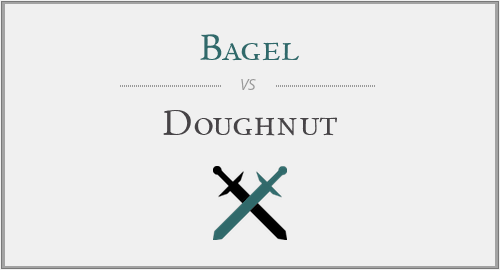Origins and Cultural Significance:
Bagels, with their origins tracing back to Jewish communities in Eastern Europe, hold a deep cultural significance. They symbolize tradition, Jewish identity, and are often associated with New York City's bustling streets. On the other hand, doughnuts have a more diverse history, with variations found in cultures such as Dutch, German, and even ancient Greek civilizations. Doughnuts have evolved to become an integral part of American culture, often associated with breakfast indulgence and sweet delights.
Ingredients and Dough:
One fundamental distinction lies in the ingredients used for bagels and doughnuts. Bagels are typically made from a simple mixture of flour, water, yeast, salt, and malt syrup. The dough is boiled before being baked, resulting in a chewy texture and a shiny, slightly crispy exterior. Doughnuts, on the other hand, are enriched with ingredients such as eggs, sugar, butter, and milk. This enriched dough is often deep-fried to achieve a soft, fluffy interior and a golden, slightly crispy exterior.
Shape and Toppings:
Bagels are characterized by their distinctive shape—round with a hole in the center. This shape allows for even baking and provides a convenient space for spreading cream cheese, butter, or other toppings. Bagels can be found in various flavors such as plain, sesame, poppy seed, cinnamon-raisin, and everything, each offering a unique taste experience. Doughnuts, in contrast, come in a variety of shapes, including ring-shaped, filled, or twisted. They are renowned for their ability to accommodate an array of glazes, icings, sprinkles, or even fillings like jam, cream, or custard.

Serving and Consumption:
Bagels are often sliced horizontally and enjoyed as a sandwich base or toasted and served with spreads or as a side to accompany soups or salads. Doughnuts, on the other hand, are typically served as standalone treats, either enjoyed fresh from the bakery or paired with a cup of coffee. They often evoke a sense of indulgence and are commonly savored during breakfast or as a dessert option.
Conclusion:
Bagels and doughnuts may share a common round shape and a doughy composition, but their differences extend far beyond their appearances. While bagels embody tradition, cultural heritage, and a chewy texture, doughnuts represent a rich, sweet indulgence and offer a wide range of flavors and toppings. Understanding the distinctions between bagels and doughnuts allows us to appreciate their unique qualities and the cultural significance they hold in various parts of the world. So, whether one prefers the satisfying chew of a bagel or the sweet delight of a doughnut, both of these baked goods continue to captivate taste buds and bring joy to countless individuals worldwide.




Have a discussion about this article with the community:
Report Comment
We're doing our best to make sure our content is useful, accurate and safe.
If by any chance you spot an inappropriate comment while navigating through our website please use this form to let us know, and we'll take care of it shortly.
Attachment
You need to be logged in to favorite.
Log In